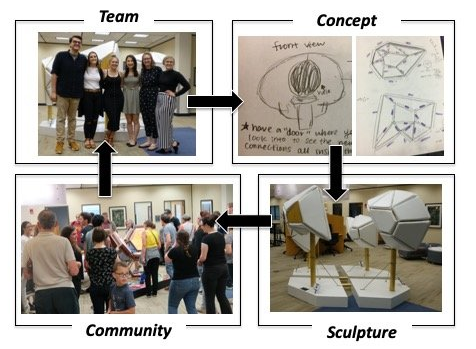The CESTA program was an NSF funded program designed to bring together students in the science, engineering and art disciplines to design and build an interactive science-art installation in Morgantown. The objective of the program was to train and encourage students from all disciplines to educate and engage the people of Morgantown, and their own communities, to discuss science as it pertains to our daily lives and decisions, and to introduce the beauty of science through art and understanding.
The program ran for four summers from 2017-2020 and the outcomes were published in the Journal of Chemical Education.
See the creativity and excitement of CESTA student teams on the Program Outcomes page.

Community Engagement in Science Through Art


The CESTA Program program offered a unique opportunity for students to express their creativity within the parameters of a collaborative and common goal. The program fostered the creative dexterity, communication, and leadership abilities of our students - traits sought after by hiring managers and skills needed to address our world's most complex challenges.
The objective of the CESTA summer program was to train and encourage students from all disciplines to educate and engage the community to discuss science as it pertains to our daily lives and decisions, and to introduce the beauty of science through art and understanding.
In many current efforts to improve scientific literacy (e.g. museums, internet videos, etc.) the scientific community is asking the public to seek out the venues and resources. Our goal is to bring science to the community in a format that is fun, interesting, educational and beautiful. We took great inspiration from the amazing work of Blue Trail and open lab on their innovative and exciting project Oceanic Scales. We also appreciate the time and input they shared in the early brainstorming stages of our project!
The content of each installation was determined by the student participants. We believe that the process of developing an idea, evaluating its relevance, and making the science accessible and interactive is just as important as designing and building the display. These conversations are the essence of what we aim to develop. For this reason, the student participants were actively involved in each stage of the project.
Student participants were expected to:
- Brainstorm together to develop an idea or concept to share with the community
- Identify a public location and secure permission for the installation
- Design, build and install the piece
- Participate in weekly seminars from leaders in the area of interactive science and science-art collaboration
As a result, the student participants made and developed skills to communicate effectively across fields and with the broader community.
The program ran for four summers from 2017-2020 and the outcomes were published in the the Journal of Chemical Education.
See the creativity and excitement of the 2016 and 2017 teams on the Program Outcomes page.
All Rights Reserved | The Hoover Lab
